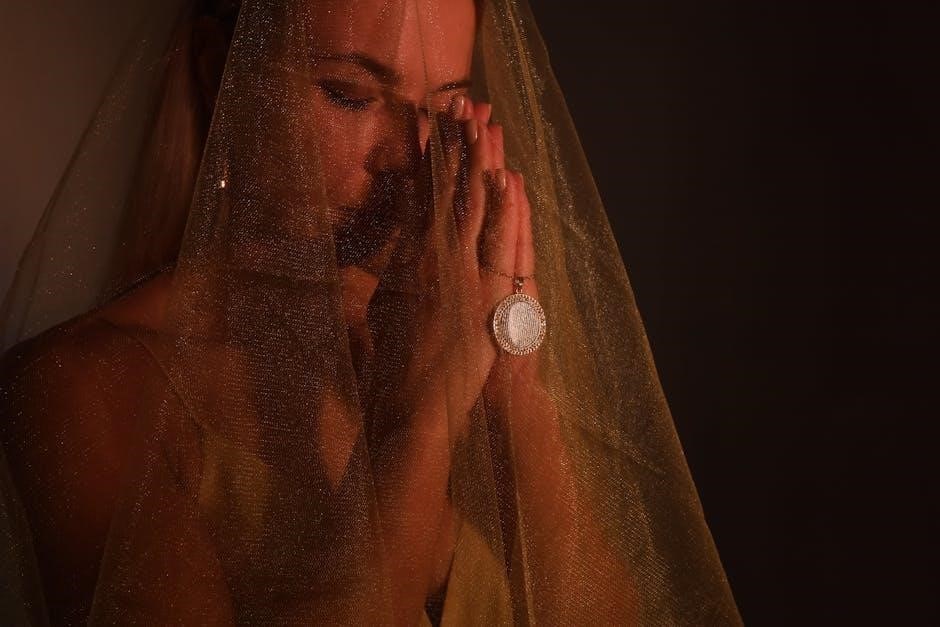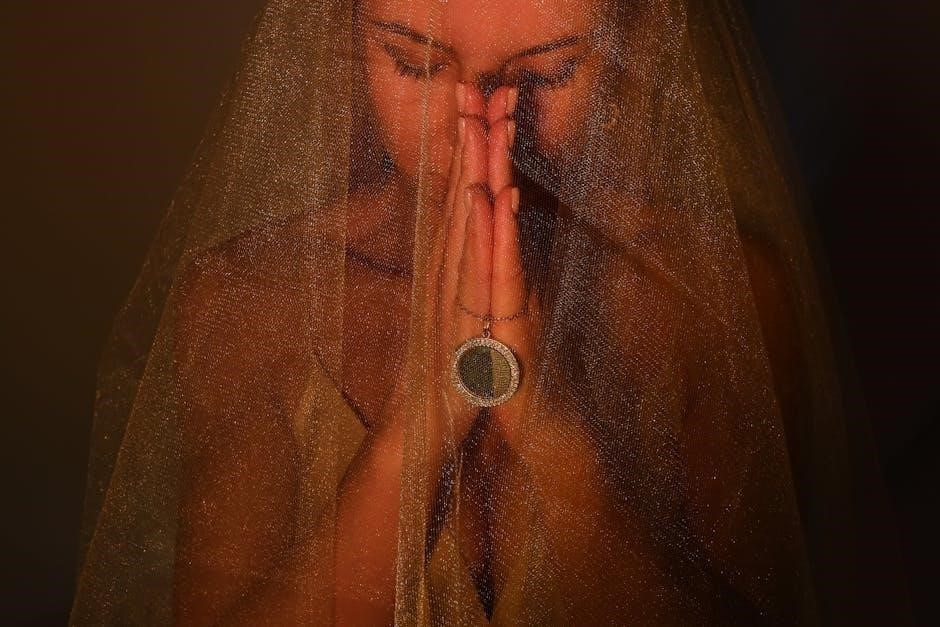tefillin prayer pdf
Tefillin are sacred leather boxes worn during morning prayers, containing Torah verses that connect Jews to their faith and heritage. The act of donning Tefillin symbolizes devotion, unity, and adherence to Jewish tradition, fostering a profound spiritual experience.
Significance of Tefillin in Jewish Prayer
Tefillin hold profound spiritual and symbolic meaning in Jewish prayer, serving as a physical and emotional connection to the Torah and divine service. They embody the unity of the Jewish people across generations, linking the wearer to a legacy of faith and practice. The act of wearing Tefillin is a declaration of devotion, fostering a deeper sense of purpose and mindfulness during prayer. It is also a tangible expression of the commandment to bind the words of God upon one’s heart, as stated in the Torah. The recitation of the Shema prayer while wearing Tefillin further strengthens this bond, creating a sacred moment of introspection and spiritual elevation.

Basic Components of Tefillin
Tefillin consist of two leather boxes, known as Batim, which house sacred parchments called Parshiyot. These parchments are inscribed with specific Torah portions, including the Shema and passages from Exodus. The boxes are connected by leather straps, or Retzuot, used to secure them to the arm and head. The Shel Yad (hand Tefillin) is placed on the bicep, while the Shel Rosh (head Tefillin) rests above the forehead. The manufacturing process involves meticulous craftsmanship to ensure the boxes are perfectly formed and the straps are precisely woven. These components work together to fulfill the commandment of binding the words of God, creating a tangible connection to faith and tradition during prayer.
Overview of the Tefillin Prayer Process
The Tefillin prayer process begins with reciting a blessing before donning the leather boxes. The Shel Yad is placed on the bicep, while the Shel Rosh is positioned above the forehead. The straps are carefully wrapped around the arm and hand, symbolizing the binding of faith. The central prayer recited is the Shema, which emphasizes the unity of God. Additional prayers and passages may follow, depending on tradition. The process is typically performed during weekday mornings, excluding holidays. The act of wearing Tefillin is a deeply personal and meditative experience, fostering a connection to Jewish heritage and spiritual renewal. Proper technique and intention are essential to fulfill the commandment meaningfully.
History and Origins of Tefillin
Tefillin trace their origins to biblical times, with the commandment appearing in Exodus and Deuteronomy. This sacred practice has been observed for millennia, connecting Jews to their heritage.
Biblical Commandment and References
The commandment to wear Tefillin is rooted in the Torah, specifically in Exodus 13:9-10 and Deuteronomy 6:8, where Jews are instructed to bind God’s words upon their hands and between their eyes. These verses emphasize the importance of remembering divine redemption and adhering to Jewish law. The Tefillin serve as a physical reminder of the covenant between God and the Jewish people, ensuring that spiritual connection remains central to daily life. This practice, observed for millennia, reflects a deep commitment to faith and tradition, linking each generation to the sacred texts of their ancestors.
Evolution of Tefillin Through the Ages
Tefillin have undergone a remarkable evolution since their origins in ancient Jewish practice. The earliest references to Tefillin appear in the Torah, with the commandment to bind God’s words on the hand and head. Over centuries, the design and materials used for Tefillin have been refined, with sages like Rabbi Yehuda HaNasi and Maimonides contributing to their standardization. The Talmudic era saw debates about the placement of the straps and the parchments inside the boxes. In the Middle Ages, the production of Tefillin became more precise, with strict adherence to halachic guidelines. Today, Tefillin are worn by observant Jews worldwide, blending tradition with modern manufacturing techniques. Their enduring significance reflects a deep connection to Jewish heritage and spiritual practice, ensuring their relevance across generations.

Cultural and Spiritual Significance
Tefillin hold profound cultural and spiritual significance in Jewish life, serving as a tangible connection to faith and heritage. They embody the unity of the Jewish people across generations, symbolizing a commitment to Torah values and divine service. The act of wearing Tefillin during prayer fosters a deep sense of spiritual elevation, linking the individual to the collective Jewish experience. It is a physical manifestation of devotion, reminding the wearer of their covenant with God. Tefillin also represent a bridge between the physical and spiritual worlds, emphasizing the importance of mindfulness and intention in daily worship. Their use is a powerful expression of Jewish identity, transcending time and circumstance to inspire and unite believers worldwide.
Structure and Components of Tefillin
Tefillin consist of leather boxes (Batim) containing parchments (Parshiyot) with Torah verses, secured by straps (Retzuot). The meticulous manufacturing process ensures their traditional and spiritual integrity, enabling proper use in prayer.

The Leather Boxes (Batim)

The Batim are handcrafted leather boxes that house the sacred parchments (Parshiyot) containing verses from the Torah, specifically sections of the Shema prayer. These boxes are meticulously constructed to ensure they meet strict halachic standards, reflecting their holy purpose. The Batim are designed with precision, featuring compartments to hold the scrolls securely. Their craftsmanship is a testament to the reverence for Tefillin, as they are considered a physical manifestation of the connection between the divine and the wearer. The Batim are worn on the arm and head, symbolizing the binding of faith and tradition. Their durability and intricate design underscore their enduring significance in Jewish prayer rituals.
The Straps (Retzuot)
The Retzuot are the black leather straps used to secure the Tefillin boxes (Batim) to the arm and head. Made from thick, durable leather, these straps are carefully crafted to ensure they are smooth and even, adhering to halachic standards. The Retzuot play a crucial role in the Tefillin ritual, as they bind the sacred boxes to the body, symbolizing the connection between the wearer and the divine. The straps are wound around the arm and head in a specific manner, creating a physical and spiritual bond. Their black color signifies their holiness and the importance of the mitzvah they facilitate. The Retzuot are essential for the proper wearing of Tefillin, ensuring the boxes remain in their correct positions during prayer.

The Parchments (Parshiyot)
The Parshiyot are the sacred parchment scrolls placed inside the Tefillin boxes (Batim). These parchments contain specific Torah portions, including the Shema, Vehaya, and Bo, which are central to Jewish faith. The text is meticulously written by a trained scribe using a special script to ensure accuracy and holiness. The parchment must be made from kosher animal skin and prepared with precision to meet halachic standards. Once written, the scrolls are carefully rolled and inserted into the Batim, ensuring they are properly aligned and visible. The Parshiyot symbolize the deep connection between the wearer and the divine, serving as a tangible representation of Jewish tradition and spiritual commitment during prayer. Their placement within the Tefillin is a critical part of the ritual, emphasizing the unity of body and soul in worship.
Manufacturing Process
The manufacturing of Tefillin involves meticulous craftsmanship to ensure adherence to Jewish law. Skilled artisans craft the leather boxes (Batim) from thick, durable leather, shaping them with precision to meet halachic standards. The parchments (Parshiyot) are written by trained scribes using special ink and script, carefully inscribing Torah verses. The scrolls are then rolled and placed inside the Batim, which are sealed and fitted with straps (Retzuot). The process requires extreme attention to detail, as any imperfection can render the Tefillin invalid. The leather straps are also carefully prepared, ensuring they are smooth and even. Finally, the Tefillin are inspected for any flaws before being deemed ready for use in prayer, ensuring they are both functional and spiritually pure.

Rituals and Prayers Associated with Tefillin

Tefillin rituals include reciting blessings upon donning them, such as “Baruch atah Adonai,” and praying the Shema. Additional prayers are recited while wearing Tefillin, enhancing spiritual connection.

Blessings Upon Putting on Tefillin
Reciting blessings is a vital part of donning Tefillin, expressing gratitude for the commandment. The primary blessing is “Baruch atah Adonai, Eloheinu, Melech ha’olam, asher kidshanu b’mitzvotav v’tzivanu l’haniach tefillin.” This blessing acknowledges the sanctity of the act and the divine commandment. Additional prayers, such as the Shema, are recited while wearing Tefillin, deepening the spiritual connection. These blessings are recited daily, emphasizing the wearer’s commitment to Jewish tradition and faith. The act of reciting these blessings is a moment of reflection, connecting the individual to generations of Jews who have fulfilled this mitzvah. Proper intention and focus during the recitation are considered essential for the blessings to be meaningful and effective.
The Shema Prayer and Its Connection to Tefillin
The Shema prayer is a central component of Jewish worship, and its recitation is deeply intertwined with the act of wearing Tefillin. The Shema, found in Deuteronomy 6:4-9 and 11:13-21, declares the unity of God and is a profound expression of faith. When wearing Tefillin, the Shema is recited to emphasize the connection between the physical act of donning Tefillin and the spiritual affirmation of Jewish belief. The prayer is often recited with heightened intention while wearing Tefillin, as the boxes symbolize the binding of God’s commandments to the heart and mind. This practice strengthens the wearer’s commitment to Jewish tradition and fosters a deeper sense of spiritual awareness during prayer.
Other Prayers Recited While Wearing Tefillin
Beyond the Shema, several other prayers and passages are traditionally recited while wearing Tefillin, enhancing the spiritual experience. These include the prayer “Vehaya ki yeviehcha,” which expresses gratitude for divine guidance, and “Leolam yehei Adam,” a meditation on humility and faith. Additionally, some recite passages from the Torah, such as the account of the Exodus, to deepen their connection to Jewish heritage. These prayers are often recited with heightened intention, as the Tefillin serve as a physical reminder of the commandments and the unity of the Jewish people. The practice fosters a sense of spiritual elevation and mindfulness during prayer, reinforcing the wearer’s commitment to their faith and traditions. This ritual enriches the morning prayer service, making it a meaningful and transformative experience.
Proper Way to Wear Tefillin
The proper way to wear Tefillin involves precise steps to ensure correctness and intentionality. The arm Tefillin is placed on the left arm (for right-handed individuals) and wrapped toward the heart, while the head Tefillin is positioned above the forehead, centered between the eyes. The straps are tied in a specific manner, forming a loop for the arm and a “dalet” shape on the hand. The Tallit is typically donned before the Tefillin, as the Tefillin are considered holier. Blessings are recited upon putting them on, emphasizing the divine commandment. Proper alignment and tightness are crucial to maintain focus during prayer. This meticulous process reflects deep respect for the tradition and enhances the spiritual connection. The wearer must ensure the Tefillin remain properly positioned throughout the prayers. This practice requires attention and care to fulfill the mitzvah accurately. The Tefillin serve as a physical and spiritual reminder of faith and devotion. The process is deeply rooted in tradition and is performed with intentionality to honor the commandment. The proper way to wear Tefillin is a meaningful act that connects the wearer to Jewish heritage and spiritual practice. The Tefillin must be worn with mindfulness and care to ensure the ritual is performed correctly. The proper way to wear Tefillin is a vital part of Jewish prayer, requiring attention to detail and intentionality. The Tefillin are worn with precision to maintain their sanctity and significance. The proper way to wear Tefillin is a tradition passed down through generations, ensuring continuity and connection to faith. The Tefillin are worn with care to honor the divine commandment and to deepen spiritual awareness. The proper way to wear Tefillin is a meaningful and intentional act that enriches the prayer experience. The Tefillin are worn with precision to ensure the ritual is performed correctly and with the utmost respect. The proper way to wear Tefillin is a vital part of Jewish tradition, requiring attention to detail and intentionality. The Tefillin are worn with care to maintain their sanctity and significance. The proper way to wear Tefillin is a tradition passed down through generations, ensuring continuity and connection to faith. The Tefillin are worn with care to honor the divine commandment and to deepen spiritual awareness. The proper way to wear Tefillin is a meaningful and intentional act that enriches the prayer experience. The Tefillin are worn with precision to ensure the ritual is performed correctly and with the utmost respect. The proper way to wear Tefillin is a vital part of Jewish tradition, requiring attention to detail and intentionality. The Tefillin are worn with care to maintain their sanctity and significance. The proper way to wear Tefillin is a tradition passed down through generations, ensuring continuity and connection to faith. The Tefillin are worn with care to honor the divine commandment and to deepen spiritual awareness. The proper way to wear Tefillin is a meaningful and intentional act that enriches the prayer experience. The Tefillin are worn with precision to ensure the ritual is performed correctly and with the utmost respect. The proper way to wear Tefillin is a vital part of Jewish tradition, requiring attention to detail and intentionality. The Tefillin are worn with care to maintain their sanctity and significance. The proper way to wear Tefillin is a tradition passed down through generations, ensuring continuity and connection to faith. The Tefillin are worn with care to honor the divine commandment and to deepen spiritual awareness. The proper way to wear Tefillin is a meaningful and intentional act that enriches the prayer experience. The Tefillin are worn with precision to ensure the ritual is performed correctly and with the utmost respect. The proper way to wear Tefillin is a vital part of Jewish tradition, requiring attention to detail and intentionality. The Tefillin are worn with care to maintain their sanctity and significance. The proper way to wear Tefillin is a tradition passed down through generations, ensuring continuity and connection to faith. The Tefillin are worn with care to honor the divine commandment and to deepen spiritual awareness. The proper way to wear Tefillin is a meaningful and intentional act that enriches the prayer experience. The Tefillin are worn with precision to ensure the ritual is performed correctly and with the utmost respect. The proper way to wear Tefillin is a vital part of Jewish tradition, requiring attention to detail and intentionality. The Tefillin are worn with care to maintain their sanctity and significance. The proper way to wear Tefillin is a tradition passed down through generations, ensuring continuity and connection to faith. The Tefillin are worn with care to honor the divine commandment and to deepen spiritual awareness. The proper way to wear Tefillin is a meaningful and intentional act that enriches the prayer experience. The Tefillin are worn with precision to ensure the ritual is performed correctly and with the utmost respect. The proper way to wear Tefillin is a vital part of Jewish tradition, requiring attention to detail and intentionality. The Tefillin are worn with care to maintain their sanctity and significance. The proper way to wear Tefillin is a tradition passed down through generations, ensuring continuity and connection to faith. The Tefillin are worn with care to honor the divine commandment and to deepen spiritual awareness. The proper way to wear Tefillin is a meaningful and intentional act that enriches the prayer experience. The Tefillin are worn with precision to ensure the ritual is performed correctly and with the utmost respect. The proper way to wear Tefillin is a vital part of Jewish tradition, requiring attention to detail and intentionality. The Tefillin are worn with care to maintain their sanctity and significance. The proper way to wear Tefillin is a tradition passed down through generations, ensuring continuity and connection to faith. The Tefillin are worn with care to honor the divine commandment and to deepen spiritual awareness. The proper way to wear Tefillin is a meaningful and intentional act that enriches the prayer experience. The Tefillin are worn with precision to ensure the ritual is performed correctly and with the utmost respect. The proper way to wear Tefillin is a vital part of Jewish tradition, requiring attention to detail and intentionality. The Tefillin are worn with care to maintain their sanctity and significance. The proper way to wear Tefillin is a tradition passed down through generations, ensuring continuity and connection to faith. The Tefillin are worn with care to honor the divine commandment and to deepen spiritual awareness. The proper way to wear Tefillin is a meaningful and intentional act that enriches the prayer experience. The Tefillin are worn with precision to ensure the ritual is performed correctly and with the utmost respect. The proper way to wear Tefillin is a vital part of Jewish tradition, requiring attention to detail and intentionality. The Tefillin are worn with care to maintain their sanctity and significance. The proper way to wear Tefillin is a tradition passed down through generations, ensuring continuity and connection to faith. The Tefillin are worn with care to honor the divine commandment and to deepen spiritual awareness. The proper way to wear Tefillin is a meaningful and intentional act that enriches the prayer experience. The Tefillin are worn with precision to ensure the ritual is performed correctly and with the utmost respect. The proper way to wear Tefillin is a vital part of Jewish tradition, requiring attention to detail and intentionality. The Tefillin are worn with care to maintain their sanctity
Order of Donning Tefillin and Tallit
The proper order of donning Tefillin and Tallit is a significant aspect of Jewish prayer. Tradition dictates that the Tallit is put on first, followed by the Tefillin. This sequence reflects the principle of ascending in holiness, as Tefillin are considered more sacred than the Tallit. The Tallit is wrapped around the shoulders, and its tzitzit are then checked and adjusted. After reciting the blessing for the Tallit, the Tefillin are donned. The arm Tefillin is placed on the left arm (for right-handed individuals) and wrapped toward the heart, while the head Tefillin is positioned above the forehead. The blessings for Tefillin are recited after they are securely in place. This order ensures that the wearer progresses from a lesser to a greater mitzvah, enhancing the spiritual experience of prayer. The sequence is deeply rooted in tradition and is followed meticulously to honor the commandments. The order of donning Tefillin and Tallit is a meaningful ritual that reflects the importance of intentionality and holiness in Jewish practice. The proper sequence is essential to fulfill the mitzvah correctly and to maintain the sanctity of the act. The order of donning Tefillin and Tallit is a vital part of Jewish tradition, ensuring that the wearer approaches prayer with the appropriate mindset and reverence. The sequence is a beautiful expression of faith and commitment to Jewish law. The order of donning Tefillin and Tallit is a tradition passed down through generations, connecting the wearer to their heritage and spiritual practice. The proper sequence is a testament to the enduring legacy of Jewish rituals and their profound significance. The order of donning Tefillin and Tallit is a meaningful and intentional act that enriches the prayer experience. The sequence is a vital part of Jewish tradition, requiring attention to detail and respect for the commandments. The order of donning Tefillin and Tallit is a tradition that continues to inspire and guide Jews in their spiritual journey. The proper sequence is a reflection of the deep connection between faith and practice in Jewish life. The order of donning Tefillin and Tallit is a tradition that emphasizes the importance of order and intentionality in serving the divine. The sequence is a beautiful expression of Jewish devotion and commitment to sacred rituals. The order of donning Tefillin and Tallit is a tradition that continues to be observed with reverence and care, ensuring the continuity of Jewish heritage. The proper sequence is a testament to the enduring significance of Jewish traditions in modern times. The order of donning Tefillin and Tallit is a meaningful and intentional act that enriches the prayer experience. The sequence is a vital part of Jewish tradition, requiring attention to detail and respect for the commandments. The order of donning Tefillin and Tallit is a tradition that continues to inspire and guide Jews in their spiritual journey. The proper sequence is a reflection of the deep connection between faith and practice in Jewish life. The order of donning Tefillin and Tallit is a tradition that emphasizes the importance of order and intentionality in serving the divine. The sequence is a beautiful expression of Jewish devotion and commitment to sacred rituals. The order of donning Tefillin and Tallit is a tradition that continues to be observed with reverence and care, ensuring the continuity of Jewish heritage. The proper sequence is a testament to the enduring significance of Jewish traditions in modern times. The order of donning Tefillin and Tallit is a meaningful and intentional act that enriches the prayer experience. The sequence is a vital part of Jewish tradition, requiring attention to detail and respect for the commandments. The order of donning Tefillin and Tallit is a tradition that continues to inspire and guide Jews in their spiritual journey. The proper sequence is a reflection of the deep connection between faith and practice in Jewish life. The order of donning Tefillin and Tallit is a tradition that emphasizes the importance of order and intentionality in serving the divine. The sequence is a beautiful expression of Jewish devotion and commitment to sacred rituals. The order of donning Tefillin and Tallit is a tradition that continues to be observed with reverence and care, ensuring the continuity of Jewish heritage. The proper sequence is a testament to the enduring significance of Jewish traditions in modern times. The order of donning Tefillin and Tallit is a meaningful and intentional act that enriches the prayer experience. The sequence is a vital part of Jewish tradition, requiring attention to detail and respect for the commandments. The order of donning Tefillin and Tallit is a tradition that continues to inspire and guide Jews in their spiritual journey. The proper sequence is a reflection of the deep connection between faith and practice in Jewish life. The order of donning Tefillin and Tallit is a tradition that emphasizes the importance of order and intentionality in serving the divine. The sequence is a beautiful expression of Jewish devotion and commitment to sacred rituals. The order of donning Tefillin and Tallit is a tradition that continues to be observed with reverence and care, ensuring the continuity of Jewish heritage. The proper sequence is a testament to the enduring significance of Jewish traditions in modern times. The order of donning Tefillin and Tallit is a meaningful and intentional act that enriches the prayer experience. The sequence is a vital part of Jewish tradition, requiring attention to detail and respect for the commandments. The order of donning Tefillin and Tallit is a tradition that continues to inspire and guide Jews in their spiritual journey. The proper sequence is a reflection of the deep connection between faith and practice in Jewish life. The order of donning Tefillin and Tallit is a tradition that emphasizes the importance of order and intentionality in serving the divine. The sequence is a beautiful expression of Jewish devotion and commitment to sacred rituals. The order of donning Tefillin and Tallit is a tradition that continues to be observed with reverence and care, ensuring the continuity of Jewish heritage. The proper sequence is a testament to the enduring significance of Jewish traditions in modern times. The order of donning Tefillin and Tallit is a meaningful and intentional act that enriches the prayer experience. The sequence is a vital part of Jewish tradition, requiring attention to detail and respect for the commandments. The order of donning Tefillin and Tallit is a tradition that continues to inspire and guide Jews in their spiritual journey. The proper sequence is a reflection of the deep connection between faith and practice in Jewish life. The order of donning Tefillin and Tallit is a tradition that emphasizes the importance of order and intentionality in serving the divine. The sequence is a beautiful expression of Jewish devotion and commitment to sacred rituals. The order of donning Tefillin and Tallit is a tradition that continues to be observed with reverence and care, ensuring the continuity of Jewish heritage. The proper sequence is a testament to the enduring significance of Jewish traditions in modern times. The order of donning Tefillin and Tallit is a meaningful and intentional act that enriches the prayer experience. The sequence is a vital part of Jewish tradition, requiring attention to detail and respect for the commandments. The order of donning Tefillin and Tallit is a tradition that continues to inspire and guide Jews in their spiritual journey. The proper sequence is a reflection of the deep connection between faith and practice in Jewish life. The order of donning Tefillin and Tallit is a tradition that emphasizes the importance of order and intentionality in serving the divine. The sequence is a beautiful expression of Jewish devotion and commitment to sacred rituals. The order of donning Tefillin and Tallit is a tradition that continues to be observed with reverence and care, ensuring the continuity of Jewish heritage. The proper sequence is a testament to the enduring significance of Jewish traditions in modern times. The order of donning Tefillin and Tallit is a meaningful and intentional act that enriches the prayer experience. The sequence is a vital part of Jewish tradition, requiring attention to detail and respect for the commandments. The order of donning Tefillin and Tallit is a tradition that continues to inspire and guide Jews in their spiritual journey. The proper sequence is a reflection of the deep connection between

Conclusion
Tefillin embody the profound connection between faith and practice, serving as a timeless symbol of Jewish devotion and spiritual commitment in daily prayer and tradition.